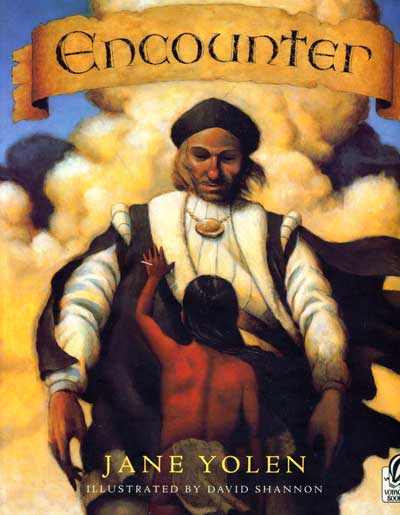Hello, readers! This week we're talking about a reading strategy called making inferences. It's where students learn to assume, or infer, things from the text that may not be explicitly written. This happens a lot when an event happens in a story and the characters who have been affected act in a certain way, like if a child slams the door shut after a fight with his or her siblings. In that instance, we can infer that the child is angry. In class this past week, we watched a read-aloud of a wonderful book called Knots on a Counting Rope; it was only close to the end of the book that we realized the child narrating part of the story was blind! He described how he saw darkness and he asked what blue was, so that's when many of us in class finally connected the dots.
There are actually a lot of books out there that are wonderful for teaching students how to make inferences.
One that we found and were really enchanted by was Encounter, by Jane Yolen. Not only are the illustrations beautiful and, again, just enchanting, the author uses wonderful, mysterious descriptions. The book is about when Christopher Columbus and his entourage landed in San Salvador in 1492. Far from the positive rhyme "In fourteen hundred ninety-two Columbus sailed the ocean blue," this story actually isn't about Columbus and it ends on a melancholy note. The story is about the natives on San Salvador and it is told by a young boy. The boy has a dream warning him that something bad is about to happen, and he tries to warn the rest of the villagers when he sees the signs that his nightmare is coming true. They ignore him because he is a child, but he continues to try to save his people. As we know from history, in the end the natives are forced to adopt European ways, including customs, clothes, religion, and more and the explorers take all the gold they can carry.
That sounds like a sad, lame book for a classroom read-aloud, right? Wrong!
Look at these descriptions of the explorers and their belongings from the point of view of the boy. Remember, he has never seen these people or the objects they brought with them. See if you can guess what the boy is describing - some are objects and some are thoughts.
1. "The hand [of the man] felt like flesh and blood, but the skin was moon to my sun."
2. "...I watched how the sky strangers touched our golden nose rings and our golden armbands but not the flesh of our faces or arms. I watched their chief smile. It was the serpent's smile - no lips and all teeth."
3. "They (the natives) desired all that the strangers had brought: the sharp silver spear; round pools to hold in the hand that gave a man back his face; darts that sprang from sticks with a sound like thunder that could kill a parrot many paces away."
So what do you think?
1. The boy is describing his dark skin compared to the stranger's white skin.
2. The boy realizes the strangers want gold and not to be friends with the natives. The serpent's smile is cunning, tricking, and dangerous.
3. The boy describes a sword, a mirror, and a gun.
Of course, many of the illustrations in the book help show what the boy is talking about. As a lesson in making inferences, though, during a read aloud a teacher could wait to show the illustrations until she was done reading the text on each page. The teacher would get the students to think about the descriptions and make inferences about what they mean. In this story, there are different emotions the boy implicitly expresses that would provide for beneficial discussions. We found this idea on Pinterest and loved it: having students write a narrative with descriptions of objects like the boy did in the story and then displaying them. It would also be fun to allow students to read each other's narratives, or to have a show and tell time where students could read their narratives to the class.
What we enjoy about this book is that, like Knots on a Counting Rope, it's a serious book. It would be great for Columbus Day of course, but also for standards teaching about the New World and exploration in world history. It's important to try to understand other people's point of view, and since we learn in American history that Columbus was a neat explorer who helped discover our country, we tend to think highly and positively of him. In this story as we read the boy's point of view, we see the greedy motive and lust for power in the explorers - far from the good image of them that we grew up with.
There is a video on YouTube about Encounter; it is a trailer of the book and could be used as a preview or a review, depending on the lesson. It also points out the importance of seeing stories and history from various points of view and not only our own.
https://www.youtube.com/watch/?v=01SKUjCCVGU



This is a wonderful book to for Celebrating Columbus Day. The Encounter helps teach children to make inferences with clues from the text. The students can share the story from a different perspective. This book can also be used in history to compare and contrast with the different version book about Christopher Columbia and the New World.*Cassandra
ReplyDelete